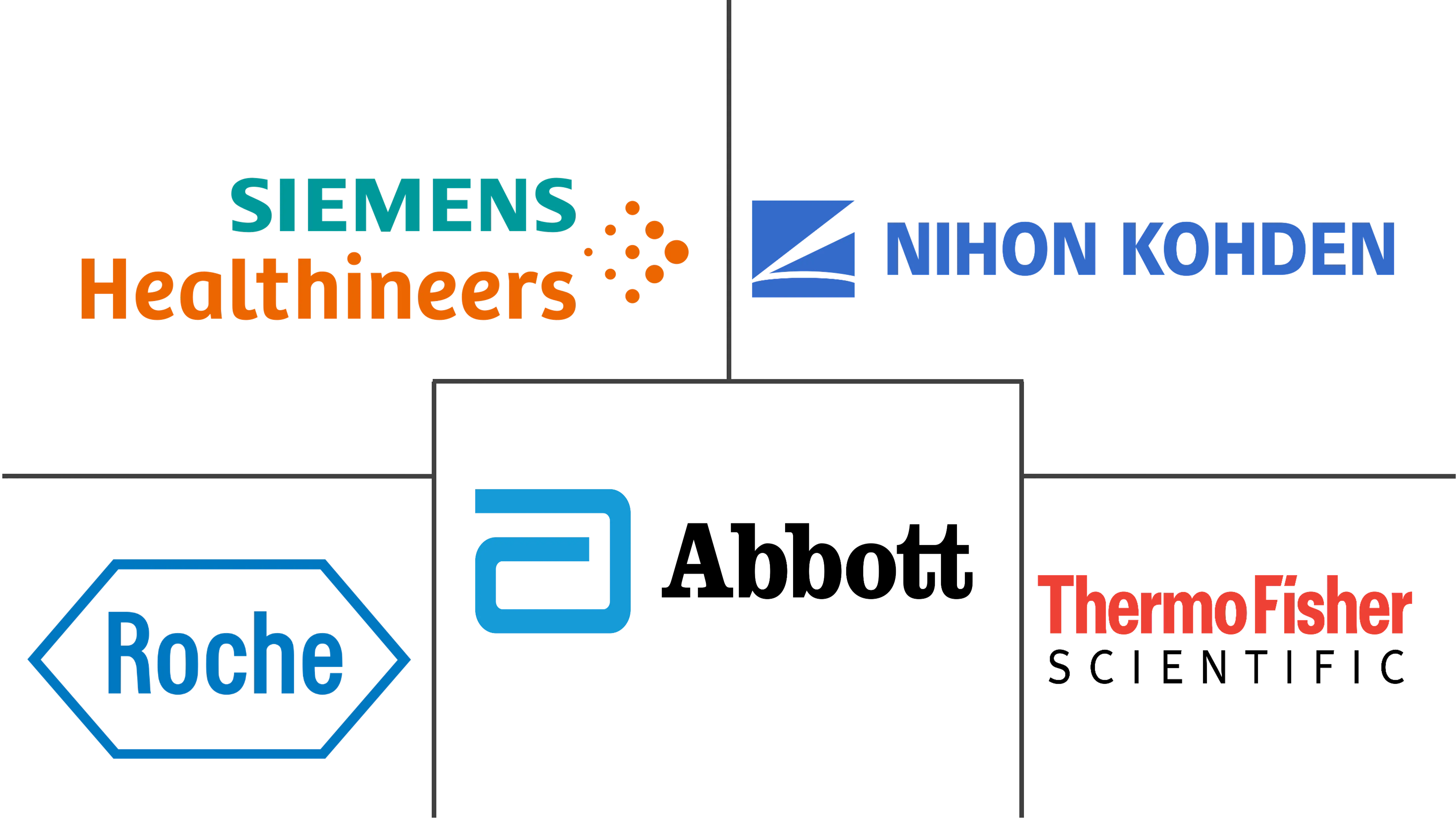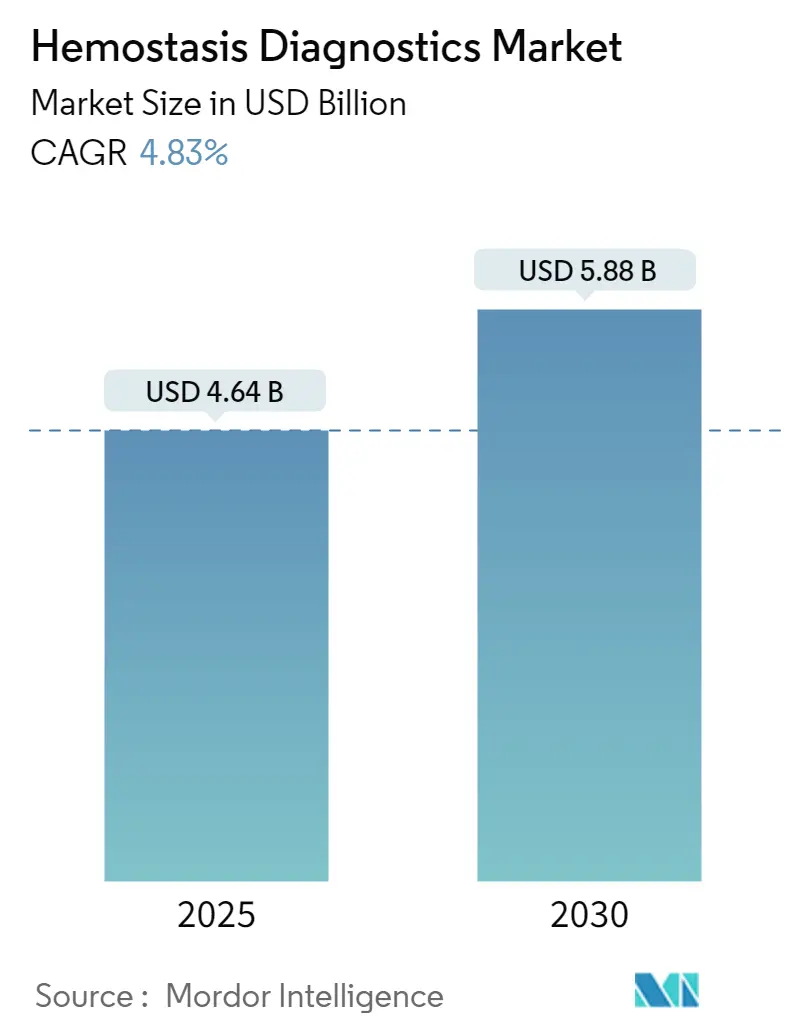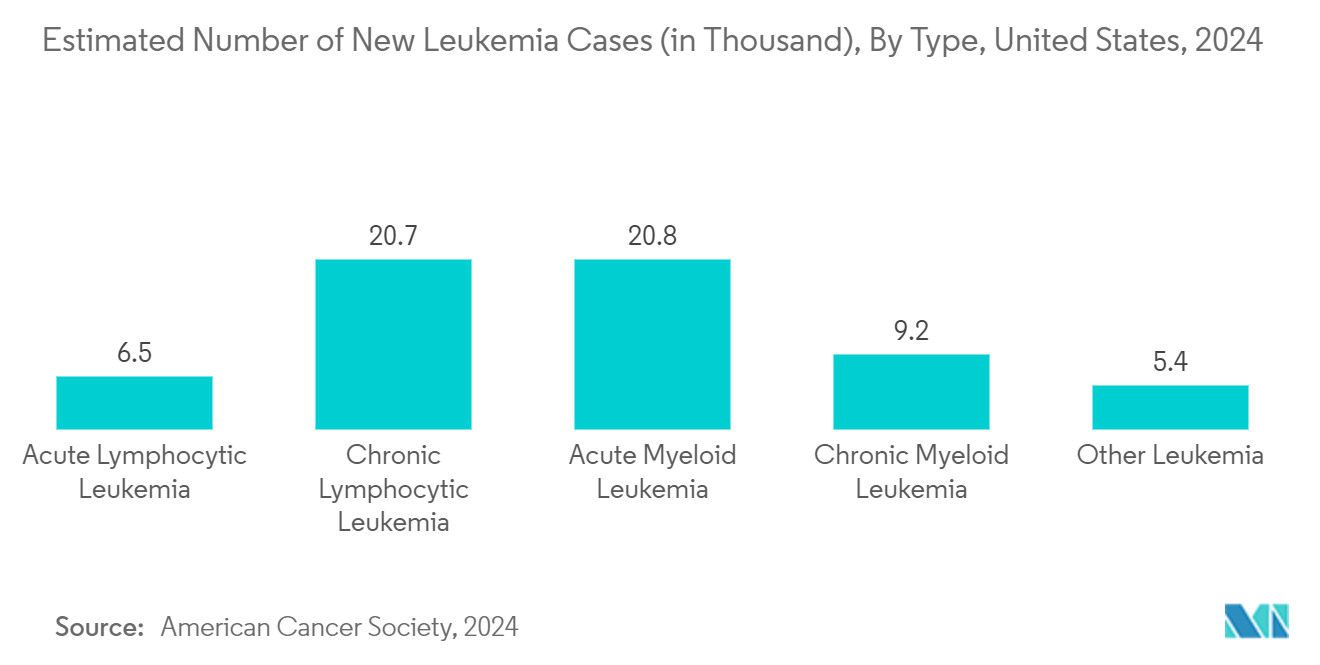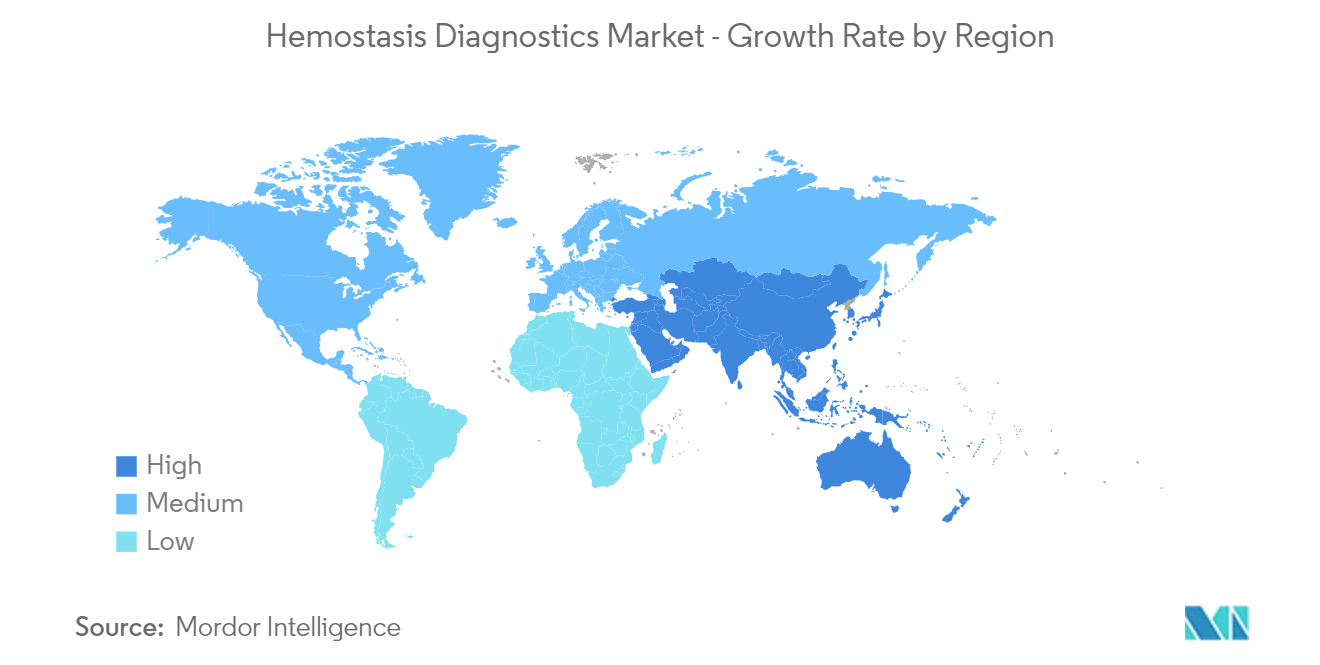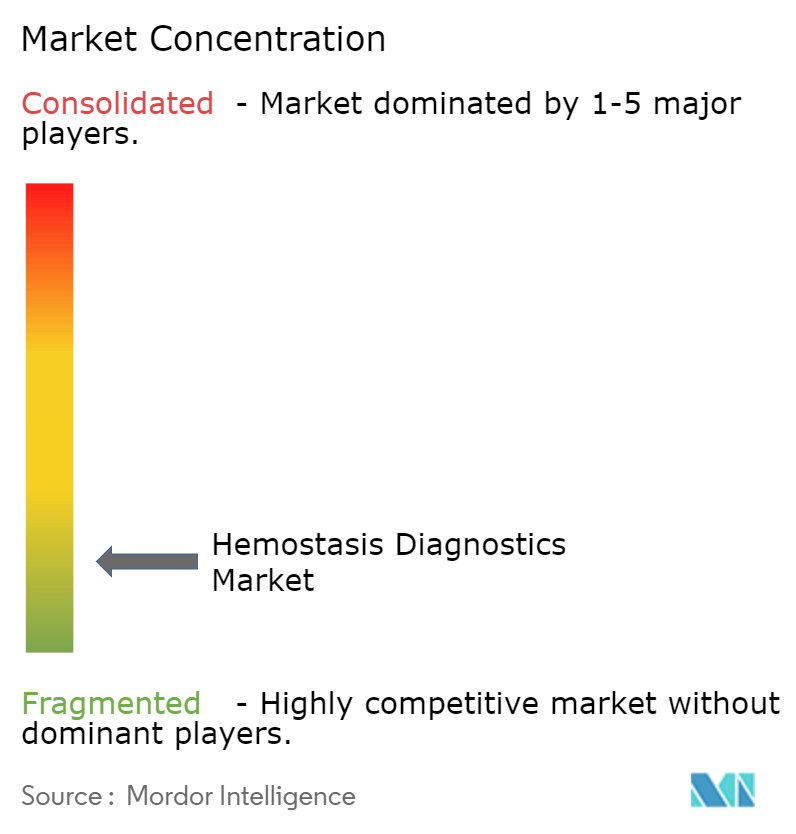Hemostasis Diagnostics Market Analysis
The Hemostasis Diagnostics Market size is estimated at USD 4.64 billion in 2025, and is expected to reach USD 5.88 billion by 2030, at a CAGR of 4.83% during the forecast period (2025-2030).
The rising incidences of bleeding and blood-related disorders, technological advancements in diagnostics, and rising adoption of automated hemostasis equipment are projected to drive the global hemostasis diagnostics market. The surge in awareness about thrombosis and coagulation disorders, growing demand for precision diagnostics, and introduction of advanced diagnostics platforms are further projected to support market growth.
- The rising prevalence of bleeding disorders, such as hemophilia and von Willebrand disease, has heightened the demand for accurate and efficient hemostasis testing. Early detection and management of these conditions are critical, driving the need for advanced diagnostic solutions.
- The notable disease burden of hemophilia is projected to offer growth opportunities for the market. For instance, according to the 2024 updated data of the National Bleeding Disorders Foundation, around 12 in 100,000 people are affected with hemophilia in the United States and around 400 children are born with this condition every year. Such a high burden of hemophilia is anticipated to bolster demand for hemostasis diagnostics to detect bleeding issues and accelerate market growth over the coming years.
- According to September 2024 data from the Hemophilia Foundation, bleeding disorders are life-threatening disorders in Australia, affecting around 7,400 people yearly. Hence, such a remarkable disease burden is projected to drive the demand for hemostasis diagnostics to provide reliable diagnosis, and this trend is expected to fuel market growth over the study period.
- Advancements in hemostasis testing technologies, such as point-of-care testing and automated analyzers, have improved the speed and accuracy of diagnostic results. These advancements make it easier for healthcare providers to perform tests and interpret results, expanding the market.
- For instance, several advantages associated with hematology tests, such as reduced turnaround time and improved accuracy, have improved their roles in critical care settings. According to an article published in Intensive Care Medicine in May 2024, hemostasis testing with platelet function testing, plasmin-antiplasmin complex (PAP) D-dimer testing, and antithrombin activity testing empowered clinicians to improve clinical outcomes in patients in critical care settings. Hence, such benefits of hemostasis testing are expected to accelerate their adoption rate over the study period.
- Various strategic agreements and collaborations undertaken by market players to strengthen the arena of hemostasis diagnostics products and consumables are further projected to offer potential growth opportunities for market growth. For instance, in March 2023, Sysmex Corporation signed a global OEM agreement with Siemens Healthcare Diagnostics Inc. focused on hemostasis products. Under this agreement, both companies were to supply each other with their respective diagnostic products in the hemostasis field on an OEM basis. Therefore, such strategic agreements undertaken by market players are expected to offer significant growth opportunities.
- Given these dynamics, including the global prevalence of hemophilia, ongoing research in hemostasis diagnostics, and proactive strategies by market players, the market is poised for notable growth. Yet, challenges like limited awareness of hemostasis disorders in developing regions and stringent government regulations are expected to hinder market expansion.
Hemostasis Diagnostics Market Trends
The Point-of-Care Testing Systems Segment is Expected to Hold a Significant Market Share During The Forecast Period.
- The point-of-care (POC) testing system segment is expected to hold a significant market share during the forecast period. Point-of-care testing is vital in emergency departments, intensive care units, and operating rooms as the results are on the spot. The segment is expected to grow due to technological advancement and the introduction of cost-effective and high-quality medical solutions.
- Leukemia and myeloma are also associated with hemostatic complications, which often require the usage of POC diagnostics for better management of the diseases. Hence, the profound burden of leukemia and associated hematology disorders is expected to propel the need for POC testing systems.
- For instance, according to 2024 data from the American Cancer Society, myeloma cases increased from 35,730 in 2023 to 35,780 in 2024. According to the Canadian Cancer Society, the incidence of leukemia is expected to rise from 6,400 in 2023 to 6,600 in 2024. Such an anticipated rise in leukemia and myeloma is likely to fuel the uptake of new-generation hematology point-of-care diagnostics to provide bedside testing, which is projected to bolster market growth over the forecast period.
- The proven efficacy of point-of-care testing systems in providing accurate diagnosis of bleeding disorders is another factor expected to benefit segment growth over the coming years. For instance, according to an article published in Current Anesthesiology Reports in June 2024, point-of-care testing, including viscoelastic coagulation tests such as rotational thromboelastometry (ROTEM) and thromboelastography (TEG), provides excellent point-of-care data on the functional clotting ability of patients with hemophilia and other blood disorders. Therefore, such reliability associated with point-of-care testing systems is further expected to bolster segment growth over the study period.
- Various market players are engaged in strategic initiatives such as research and development to develop an innovative POC testing system, contributing to the segment's growth. For instance, in January 2022, Werfen obtained 510 (k) clearance from the US Food and Drug Administration for its GEM Hemochron 100 whole-blood hemostasis testing system. The system uses Hemochron technology and provides a few minutes of activated clotting time (ACT) results. This POC testing modality enhances patient outcomes in the cardiovascular operating room and other acute care settings. Owing to the advantages point-of-care offers, the segment is expected to propel during the forecast period.
- Therefore, owing to the aforementioned factors, such as the high burden of leukemia and the growing demand for point-of-care testing for leukemia and other types of blood cancer, technological advancements in POC testing are expected to propel the segment growth during the forecast period.
The North America is Expected to Hold a Significant Market Share During The Forecast Period
- North America is expected to hold a significant market share mainly because of the high adoption of advanced automated analyzers, the presence of a large patient pool, the high prevalence of blood clot disorders, growing research efforts, and various organic and inorganic initiatives undertaken by market participants.
- The increased research efforts to develop promising diagnostic tools for bleeding disorders is one of the key factors driving regional market growth. For instance, according to an article published in Frontiers in Bioengineering and Biotechnology in October 2022, the chromogenic approach for the measurement of the Factor VIII activity levels in hemophilia A had shown excellent hemostatic capabilities in investigational studies. Therefore, such efforts to develop promising diagnostic tools are likely to bolster the availability of innovative product portfolios, and this is expected to fuel market growth over the coming years.
- In addition, various recommendations and guidelines from the hematology associations on utilizing several diagnostic tests for hemostasis are further expected to fuel regional market growth. For instance, according to an article published in the International Journal of Laboratory Hematology in November 2023, thrombin clotting time (TT) and the assessment of fibrinogen function are the most promising tests recommended by the International Council for Standardisation in Haematology (ICSH) for hemostasis. Hence, such recommendations are projected to foster market growth over the coming years.
- Therefore, owing to the above-mentioned factors, such as a surge in the burden of bleeding disorders, a growing volume of research studies, and various recommendations from the hematology associations, are expected to boost the North American market over the coming years.
Hemostasis Diagnostics Industry Overview
The hemostasis diagnostics market is fragmented due to the presence of many companies operating globally and regionally. Various organic and inorganic initiatives undertaken by market players are expected to propel the market's growth over the study period. Some market players are Abbott, Sysmex Corporation, Thermo Fisher Scientific Inc., F. Hoffmann-La Roche Ltd, Danaher, and Nihon Kohden Corporation.
Hemostasis Diagnostics Market Leaders
-
Abbott
-
Thermo Fisher Scientific, Inc.
-
F. Hoffmann-La Roche Ltd
-
Nihon Kohden Corporation
-
Siemens Healthineers AG
- *Disclaimer: Major Players sorted in no particular order
Hemostasis Diagnostics Market News
- April 2024: Sysmex Corporation and Siemens Healthcare Diagnostics Inc. began independently distributing their combined portfolio of hemostasis testing solutions to laboratories in the United States and EU countries. This initiative was based on a mutual OEM supply agreement, allowing companies to leverage their brands.
- February 2024: F. Hoffmann-La Roche Ltd launched three new coagulation tests for the oral Factor Xa inhibitors apixaban, rivaroxaban, and edoxaban in countries accepting the CE mark. This initiative aimed to enhance monitoring capabilities for patients using these anticoagulants.
Hemostasis Diagnostics Industry Segmentation
As per the scope of the report, hemostasis diagnostics are devices that help identify hemostatic defects that lead to excessive bleeding. Hemostasis is a mechanism followed by the body after getting injured. It slows down blood loss and stops blood flow. Hemostasis helps diagnose the actual cause of these disorders with history and helps in the treatment.
The hemostasis diagnostics market is segmented by product, test, end-use, and geography. By product, the market is segmented as laboratory analyzers and point-of-care testing systems. By test, the market is segmented into activated partial thromboplastin time, D-dimer test, fibrinogen test, prothrombin time (PT) test, and other tests. By end user, the market is segmented into hospitals, diagnostic centers, and other end users. The market is segmented by geography, such as North America, Europe, Asia Pacific, Middle East and Africa, and South America. The report also covers the market sizes and forecasts for the hemostasis diagnostics market in major countries across different regions. The report offers the market size in value terms in USD for all the abovementioned segments.
| By Product | Laboratory Analyzers | Automated Systems | |
| Semi-automated Systems | |||
| Manual Systems | |||
| Point-of-Care Testing Systems | |||
| By Test | Activated Partial Thromboplastin Time | ||
| D-Dimer Test | |||
| Fibrinogen Test | |||
| Prothrombin Time (PT) Test | |||
| Other Tests (Thrombin Time and Clotting Factor Assays) | |||
| By End User | Hospitals | ||
| Diagnostic Centers | |||
| Other End Users (Outpatient Clinics and Blood Banks) | |||
| Geography | North America | United States | |
| Canada | |||
| Mexico | |||
| Europe | Germany | ||
| United Kingdom | |||
| France | |||
| Italy | |||
| Spain | |||
| Rest of Europe | |||
| Asia-Pacific | China | ||
| Japan | |||
| India | |||
| Australia | |||
| South Korea | |||
| Rest of Asia-Pacific | |||
| Middle East and Africa | GCC | ||
| South Africa | |||
| Rest of Middle East and Africa | |||
| South America | Brazil | ||
| Argentina | |||
| Rest of South America | |||
Hemostasis Diagnostics Market Research FAQs
How big is the Hemostasis Diagnostics Market?
The Hemostasis Diagnostics Market size is expected to reach USD 4.64 billion in 2025 and grow at a CAGR of 4.83% to reach USD 5.88 billion by 2030.
What is the current Hemostasis Diagnostics Market size?
In 2025, the Hemostasis Diagnostics Market size is expected to reach USD 4.64 billion.
Who are the key players in Hemostasis Diagnostics Market?
Abbott, Thermo Fisher Scientific, Inc., F. Hoffmann-La Roche Ltd, Nihon Kohden Corporation and Siemens Healthineers AG are the major companies operating in the Hemostasis Diagnostics Market.
Which is the fastest growing region in Hemostasis Diagnostics Market?
Asia Pacific is estimated to grow at the highest CAGR over the forecast period (2025-2030).
Which region has the biggest share in Hemostasis Diagnostics Market?
In 2025, the North America accounts for the largest market share in Hemostasis Diagnostics Market.
What years does this Hemostasis Diagnostics Market cover, and what was the market size in 2024?
In 2024, the Hemostasis Diagnostics Market size was estimated at USD 4.42 billion. The report covers the Hemostasis Diagnostics Market historical market size for years: 2019, 2020, 2021, 2022, 2023 and 2024. The report also forecasts the Hemostasis Diagnostics Market size for years: 2025, 2026, 2027, 2028, 2029 and 2030.
Our Best Selling Reports
Hemostasis Diagnostics Industry Report
Statistics for the 2025 Hemostasis Diagnostics market share, size and revenue growth rate, created by Mordor Intelligence™ Industry Reports. Hemostasis Diagnostics analysis includes a market forecast outlook for 2025 to 2030 and historical overview. Get a sample of this industry analysis as a free report PDF download.

